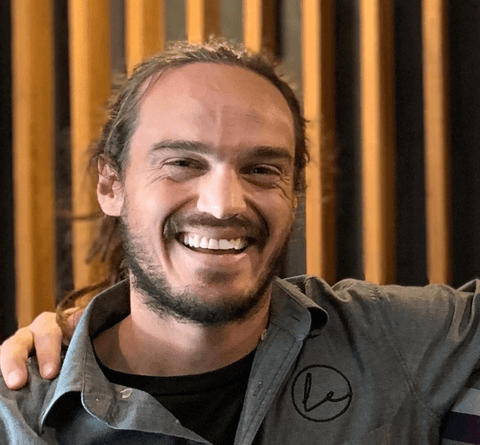
NSDR (Non-Sleep Deep Rest) is a term coined by American Neuroscientist Andrew Huberman and is a technique used to achieve a heightened state of deep and restorative relaxation. Proponents say that the regular practice of the technique helps you fall asleep more easily, reduce stress through conscious management, and achieve laser-like focus. Google CEO Sundar Pichai is reportedly a fan, but should you be too?
We cover everything you need to know about NSDR and how it can help you next!
Key Takeaways:
- NSDR (Non-Sleep Deep Rest) is a technique that helps achieve a heightened state of deep relaxation.
- Regular NSDR practice can aid in falling asleep more easily, reducing stress, and improving focus.
- NSDR is not a form of sleep but a conscious management of the brain and parasympathetic system.
- NSDR combines elements from Yoga Nidra, relaxation techniques, and deep hypnosis protocols.
- Benefits of NSDR include improved memory, increased neuroplasticity, reduced stress, enhanced focus, better pain management, and increased energy levels.
- NSDR was developed by neuroscientist Dr. Andrew Huberman.
- NSDR can be practised for 20 to 60 minutes, with regularity being more important than session length.
What is NSDR (Non-Sleep Deep Rest)?
NSDR, or Non-Sleep Deep Rest, is a guided meditation technique that helps you achieve a state of shallow sleep (like a shallow nap) during your waking hours. When practised daily or regularly, it helps you achieve better conscious control over your brain and parasympathetic nervous system (PSNS). The PSNS is what helps you relax and rest. You can fall asleep faster at night as a result.
Huberman says, "We generally have trouble falling asleep because we think we have to turn off our thoughts like a switch, but the transition to sleep involves allowing our thoughts to become fragmented," he explained. "It's then that we become relaxed, and the brain enters a more fluid state that's not under our conscious control."
An NSDR protocol involves three steps: lying in a comfortable posture, deep breathing, and body scanning. In body scanning, you're focusing your attention on different parts of your body, one after the other.
How Does NSDR Work?
NSDR utilizes brain wave frequency to induce a state of deep relaxation. Through conscious management of thoughts and focused attention, NSDR helps calm racing thoughts and promotes a state of wakefulness and tranquillity.
This technique allows the brain to enter a fluid state beyond conscious control, facilitating relaxation and rest. By regularly practising NSDR, individuals gain better control over their brain and the parasympathetic nervous system, responsible for promoting relaxation.
When you practice the NSDR protocol over time, you'll be in a better position to achieve deep relaxation at will. So, no more rolling around in your bed at night trying to fall asleep!
Who Developed NSDR?
The term NSDR was developed by Dr. Andrew Huberman, Ph.D., who, aside from being a highly-regarded neuroscientist, has several other accomplishments to his name. He's best known for his research work and thought leadership in brain development, brain plasticity, neural regeneration, and repair fields. He's currently a tenured professor at the Stanford University School of Medicine. Also, he heads the Huberman Lab, which is dedicated to all things research and development in his areas of interest.
Read more about Andrew Huberman and his credentials in our guide to Huberman's Sleep Cocktail.
Is NSDR a Re-Hash of Yoga Nidra, the Ancient Yogic Practice?
According to Huberman, NSDR isn't meditation; it certainly isn't a single isolated method. It combines different things like Yoga Nidra practice minus the spiritual components, relaxation techniques, and deep hypnosis protocols.
The centuries-old practice called Yoga Nidra incidentally isn't a bonafide meditation practice either. It's more like meditation AND sleep working side by side, or "sleeping consciously." Typically carried out at the end of yoga practice, it helps you consolidate your energy, cools your body down, and helps prepare you for meditation.
You'll first lie down against a comfortable backdrop, close your eyes, and take a few deep breaths. You then take your conscious awareness to different parts of the body one by one and clench and relax in sequence. It's similar in some ways to PMR or Progressive Muscle Relaxation. You finally bring your awareness to your body at the end. You roll over to the right gently, sit back up, and open your eyes when ready.
Yoga Nidra is seen as a powerful tool in traditional yogic practice. It's understood to have many important benefits, including eliminating stress, anxiety, and insomnia, increasing dopamine, relaxing the nervous system, reconfiguring harmful emotional patterns, and facilitating a calm state of mind.
In the formulation of NSDR, Huberman wanted to remove the spiritual components of Yoga Nidra to make it appealing to a broader audience who otherwise would not gravitate to more new-age practices.
Huberman expanded further in a Tim Ferriss podcast last year. The term NSDR emerged because" scientists like acronyms almost as much as the military likes acronyms! And I did it deliberately, not to rob the yoga community of anything but to describe this practice in more friendly, accessible language since many people would be put off by something called yoga nidra. And yet it's such a powerful tool. It's a zero-cost tool that has enormous effects on accessing sleep and calm."
Benefits of NSDR
According to Huberman, the states of deep rest possible through NSDR can help with the following:
- Improving memory and cognitive performance
- Increasing neuroplasticity which in turn enhances and helps accelerate learning
- Reducing stress and improving the quality of sleep
- Increasing focus and mental clarity
- Improving the ability to manage pain
- Energizing both the body and mind
Final Thoughts
NSDR is a great technique to adopt into your daily routine, not just to get better at restful nighttime sleep, but also to achieve peak performance. It can help you optimize your learning and memory. It can also help you gain improved mental clarity aiding smart decision-making. As with everything in life, follow the NSDR protocol consistently to get the best results.
Frequently Asked Questions (FAQs) About NSDR
Q1. What is the full form of NSDR?
The full form of NSDR is Non-Sleep Deep Rest. As the name suggests, it's a protocol that helps you achieve a state of deep relaxation during your waking hours. When practised as a daily routine, it can help you consciously regulate and achieve relaxation. Over time, you'll be able to sleep faster at night. In addition to helping you relax and reduce stress, NSDR helps you gain focus and clarity. It can also help improve your brain function, so you're better able to learn and memorise new information.
Q2. How can I practice NSDR?
NSDR isn't as complicated as it sounds. In fact, it's relatively easy to pick up. It involves lying still in a comfortable position, taking deep breaths, and body scans where you focus intensely on all the parts of your body in isolation. Devote up to 20 or 30 minutes for a single session. The easiest way to get started is to go to YouTube and follow along to a guided NSDR session. Try this quick 10-minute session guided by Huberman. Alternatively, download apps designed for creating NSDR experiences like Reveri which Huberman himself recommends.
Q2. What happens during sleep?
Sleep is a vital process that plays a crucial role in maintaining our overall well-being. When we fall into a deep sleep, our bodies and minds undergo various changes that are essential for restoring our energy levels and promoting optimal functioning.
During sleep, our brain waves slow down, and our bodies enter a state of calm and relaxation. This state allows our muscles to relax, our blood pressure to decrease, and our breathing to become slower and more regular. As we sleep, our body repairs and rejuvenates itself, promoting physical healing and growth.
Moreover, sleep is also when our brains consolidate memories and process information, enhancing our cognitive abilities. It is during this state that we truly refresh ourselves, preparing for the challenges of the next day. So, remember to prioritize quality sleep to ensure you wake up feeling revitalized and ready to take on the world.
Q3. What is the NSDR position?
The NSDR, or Non-Sleep Deep Rest position, is simply lying down in a place that's comfortable for you. Make sure your background is quiet so you can concentrate on your guided meditation. You'll get the best results if you practise NSDR protocols as part of your daily routine. Scroll up for more information on what NSDR is and how it can benefit you.
Q4. What is the difference between sleep and NSDR?
NSDR, or Non-Sleep Deep Rest, as the name suggests, isn't a form of sleep. It also doesn't induce sleep. It's a technique that helps you achieve a heightened state of relaxation. You'll be lying down practising deep breaths, and engaging in intense focus on different parts of your body in sequence. The practice helps you consciously manage your brain and parasympathetic system, which is the system that helps your body rest and relax.
Consistent practice of NSDR can help you sleep more easily at night, improve your memory and learning, increase your focus and alertness, and help you manage pain better.
Q5. What is the duration of NSDR?
Dr. Andrew Huberman, who coined the term NSDR, varies his sessions between 20 to 60 minutes depending on the time that's available to him. 20-minute sessions, when done right, can be just as effective to help you sleep better, improve your brain function, and maintain clarity and focus. The key is in regular practice as opposed to the length of the sessions.















